- Best overall: monday.com
- Best for customization: ClickUp
- Best for creators and creative teams: Notion
- Best for spreadsheet view: Smartsheet
- Best for complex project management: Wrike
- Best for budget-conscious teams: Zoho Projects
- Best for freelancers and contractors: Teamwork
- Best for agile teams: Jira
- Best for knowledge base management: Confluence
Airtable is one of the most popular project management software options, but that doesn’t mean that it’s the right choice for every team. Check out the top alternatives to Airtable to find the right project management tool based on your workflows, priorities, and specific functionality requirements.
Featured Partners
Airtable alternatives comparison table
Here is a quick overview of key features and pricing for the top Airtable alternatives:
| Star rating | Starting price | Native time tracking | Advanced reporting | Support | Gantt charts | |
|---|---|---|---|---|---|---|
| Airtable | 3.8/5 | $20 per user per month, billed annually | Limited | Yes | Limited | Easy |
| monday.com | 5/5 | $9 per user per month, billed annually | Yes | Yes | 24/7 support option | Easy |
| ClickUp | 5/5 | $7 per user per month, billed annually | Yes | Yes | 24/7 support option | Yes |
| Notion | 4.5/5 | $10 per user per month, billed annually | No | No | 24/7 support option | No |
| Smartsheet | 3.8/5 | $9 per user per month, billed annually | Yes | Yes | 24/7 support option | Yes |
| Wrike | 4.6/5 | $10.00 per user per month, billed annually | Yes | Yes | 24/7 support option | Yes |
| Zoho Projects | 4.2/5 | $4 per user per month, billed annually | Yes | No | 24/7 support option | Yes |
| Teamwork | 3.7/5 | $10.99 per user per month, billed annually | Yes | Yes | Limited | Yes |
| Jira | 4.6/5 | $8.15 per user per month for 1 to 100 users, billed monthly | Yes | Yes | 24/7 support option | Yes |
| Confluence | 4.5/5 | $6.05 per user per month for 1 to 100 users, billed monthly | No | No | 24/7 support option | No |
monday.com: Best overall

monday.com continues to be one of the most versatile and user-friendly project management tools available, making it our top choice overall. What sets monday.com apart is its ability to cater to a wide range of industries and project types, whether that’s simple task tracking or complex project management involving multiple teams. It’s flexible and easy to use, which is evident in its visual dashboards, customizable workflows, and extensive automation capabilities.
Why I chose monday.com
In my experience with monday.com, the platform stands out due to its combination of an intuitive interface and powerful features. Whether I’m managing a small project or coordinating across different teams, monday.com makes it easy to keep everything organized. Moreover, the automation features have saved me countless hours by streamlining repetitive tasks. Compared to Airtable project management tools, monday.com offered me greater flexibility in configuring different visualizations and project views.
Pricing
- Free: Supports up to two users, 1,000 items, and 500 MB of storage.
- Basic: $9 per seat per month billed annually or $12 per seat billed monthly.
- Standard: $12 per seat per month billed annually or $14 per seat billed monthly.
- Pro: $19 per seat per month billed annually or $24 per seat billed monthly.
- Enterprise: Custom pricing based on business needs.
Features
- Variety of project views, including Gantt, kanban, chart, and dashboard views.
- WorkForms feature for customizable data collection.
- Log of all changes made by users for better project tracking and visibility.
- 250+ pre-built workflow automations.
- Extensive integrations available for developer tools, CRM, and more.
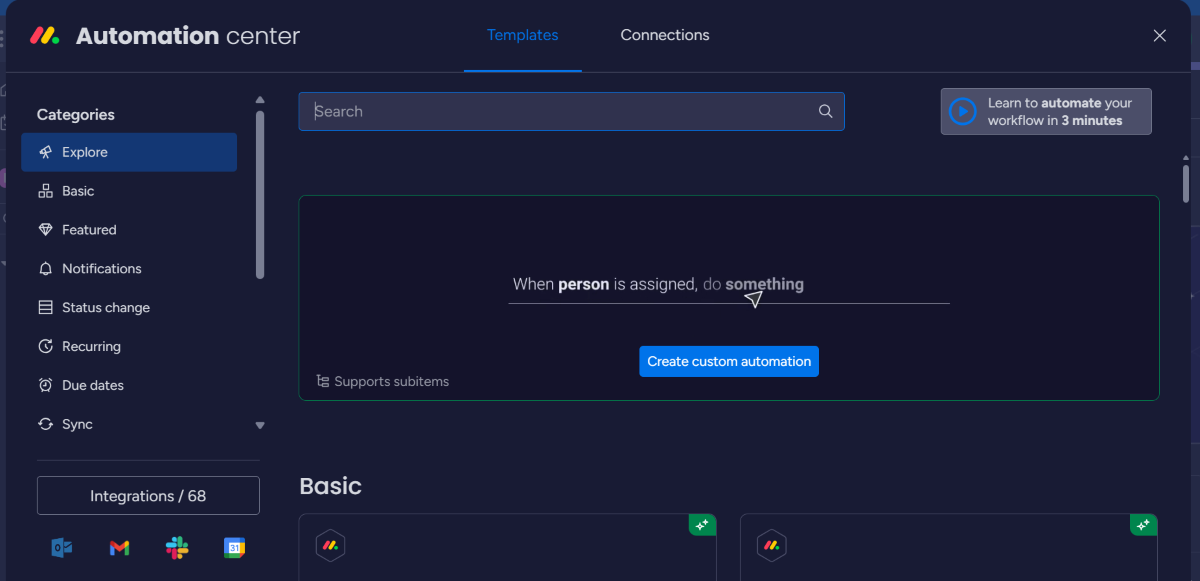
Pros and cons
| Pros | Cons |
|---|---|
| Highly customizable to fit any project type. | Higher learning curve for advanced features. |
| Excellent automation capabilities. | Can become expensive for larger teams. |
| Many views for different project needs. | Limited features on the Basic plan. |
| Strong integration options. | Easy to feel overwhelmed by the interface. |
For more information, read the full monday.com review.
ClickUp: Best for customization

ClickUp is a powerful, all-in-one, highly customizable project management tool that stands out for its ability to adapt to the needs of different teams and projects. With features that range from simple task management to advanced project tracking, ClickUp offers a thorough solution for teams of all sizes. Similar to monday.com, the platform’s flexibility is one of its greatest strengths. Users can configure their workflows, dashboards, and task views to match their specific requirements.
Why I chose ClickUp
ClickUp is a project management tool that has something for everyone. Its depth of customization is unmatched by the other options on this list. You can effortlessly build workflows from the ground up, which I found to be great for managing projects that require a unique approach. The platform also excels in its range of views, with 15+ views available.
Pricing
- Free: Supports unlimited users, tasks, and spaces with limited features.
- Unlimited: $7 per user per month billed annually or $10 per user billed monthly.
- Business: $12 per user per month billed annually or $19 per user billed monthly.
- Enterprise: Custom pricing based on business needs.
Features
- Highly customizable workflows and task statuses.
- 15+ project views, including list, board, and Gantt.
- Built-in time tracking and goal setting.
- Automation to streamline repetitive tasks.
- Extensive integration options with other tools.
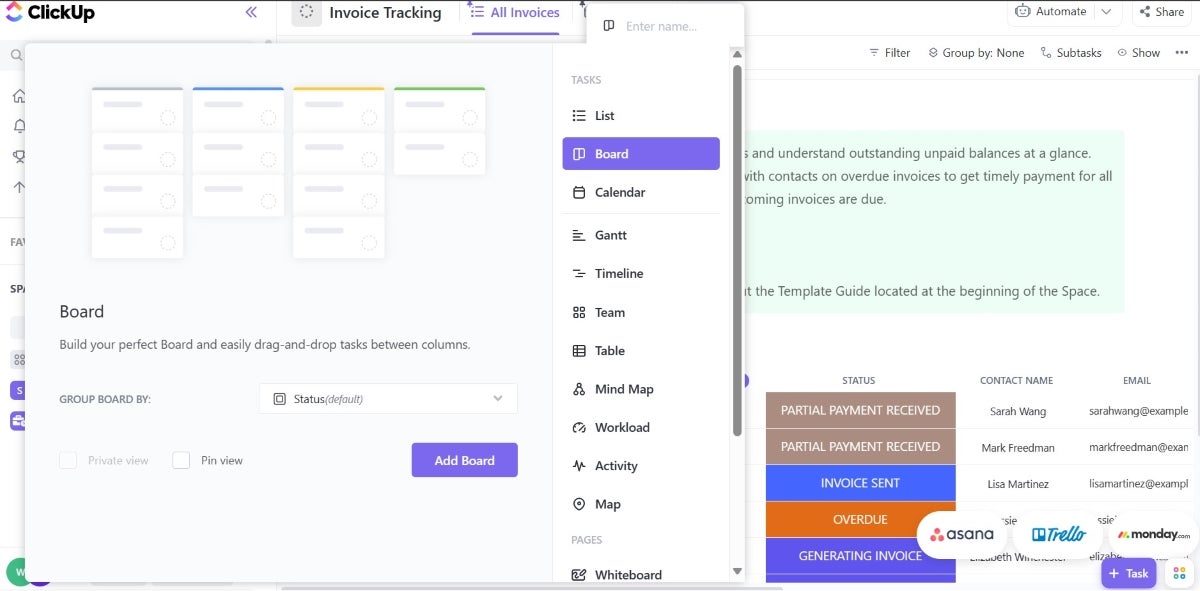
Pros and cons
| Pros | Cons |
|---|---|
| Extremely customizable workflows. | Steeper learning curve for new users. |
| Offers an effective free plan. | Performance can slow with large data sets. |
| Multiple view options to suit different needs. | Some features are only available with higher-tier plans. |
| Strong automation and integration capabilities. | The interface can feel overwhelming at first. |
For more information, read the full ClickUp review.
Notion: Best for creators and creative teams
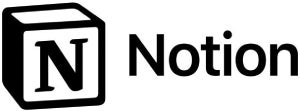
Notion is a multifaceted productivity tool that allows you to create, organize, and share notes, tasks, and projects in a centralized location. One of Notion’s key strengths is its versatility. You can use it as a simple note-taking app or as a work or project management tool. It allows you to integrate with other apps and services, such as Jira, GitHub, Zoom, Figma, Box, Google Drive, Trello, GitLab, OneDrive, and Slack, to further streamline your workflow.
Why I chose Notion
I found Notion to be an excellent alternative to Airtable because it offers a similar level of customization and data organization but with an added layer of flexibility in how you can structure and visualize your information. Notion’s ability to combine databases with rich text documents makes it incredibly versatile for managing projects—something Airtable handles less fluidly.
If you’ve ever wished for a tool that could manage your tasks and store all your project notes, resources, and ideas in one place, Notion is that tool. The platform’s intuitive drag-and-drop interface allows me to create a workspace that adapts perfectly to my workflow.
Pricing
Users can add Notion AI to any paid plan for $8 per member per month, billed annually, or $10 per member per month, billed monthly.
- Free: No charge for up to 10 guests.
- Plus: $10 per user per month, billed annually, or $12 per user billed monthly.
- Business: $15 per user per month, billed annually, or $18 per user billed monthly.
- Enterprise: Contact for pricing.
Features
- Combines task management with documentation and note-taking.
- Fully customizable workspace with drag-and-drop interface.
- Real-time collaboration with sharing and permissions.
- Supports linked databases for connected information management.
- Knowledge management capabilities.
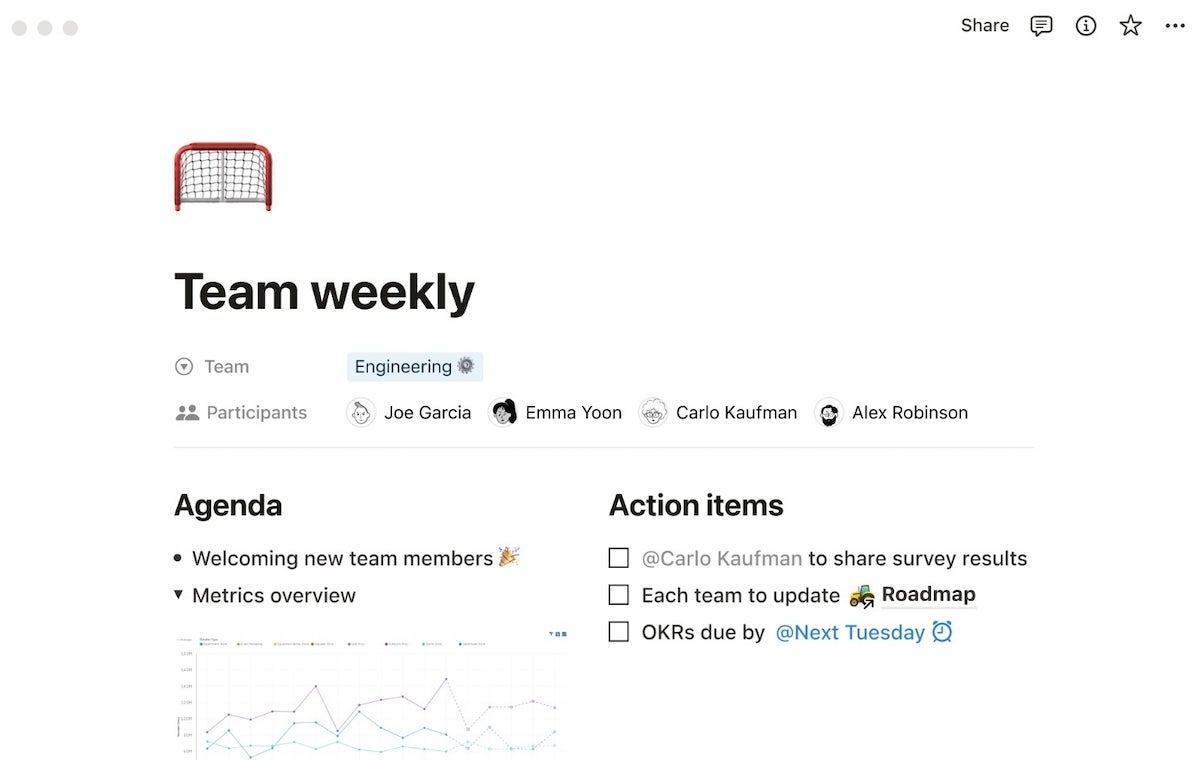
Pros and cons
| Pros | Cons |
|---|---|
| Highly flexible and customizable workspace. | Can be overwhelming for new users. |
| Combines multiple functions in one platform. | Lacks advanced project management features. |
| Great for documentation and knowledge management. | Performance can lag with large databases. |
| Real-time collaboration with easy sharing. | Unsuitable for large projects. |
For more information, read the full Notion review.
Smartsheet: Best for spreadsheet view

Smartsheet is highly rated cloud-based project management software that can meet the needs of teams of various sizes, focus areas, and technical skill levels. The tool makes it easy to organize, visualize, and communicate clearly about ongoing projects. Like Airtable, Smartsheet displays project data through a spreadsheet-like interface.
Why I chose Smartsheet
Smartsheet is an alternative to Airtable for those who prefer a spreadsheet-like interface but want more advanced project management features. Smartsheet bridges the gap between traditional spreadsheets and dedicated project management tools, which provides a familiar environment for anyone who has worked with spreadsheets before with far more capability for managing large projects.
Pricing
- Free: No cost for up to one user and two editors.
- Pro: $9 per user per month billed annually, or $12 per user per month billed monthly.
- Business: $19 per user per month billed annually, or $24 per user per month billed monthly.
- Enterprise: Customized pricing.
Features
- Spreadsheet-like interface with enhanced project management features.
- Advanced workflow automation and process management.
- Pre-built project and automation templates.
- Data visualization through grid, Gantt, card, and calendar views.
- WorkApps is a code-free tool for building web and mobile apps.
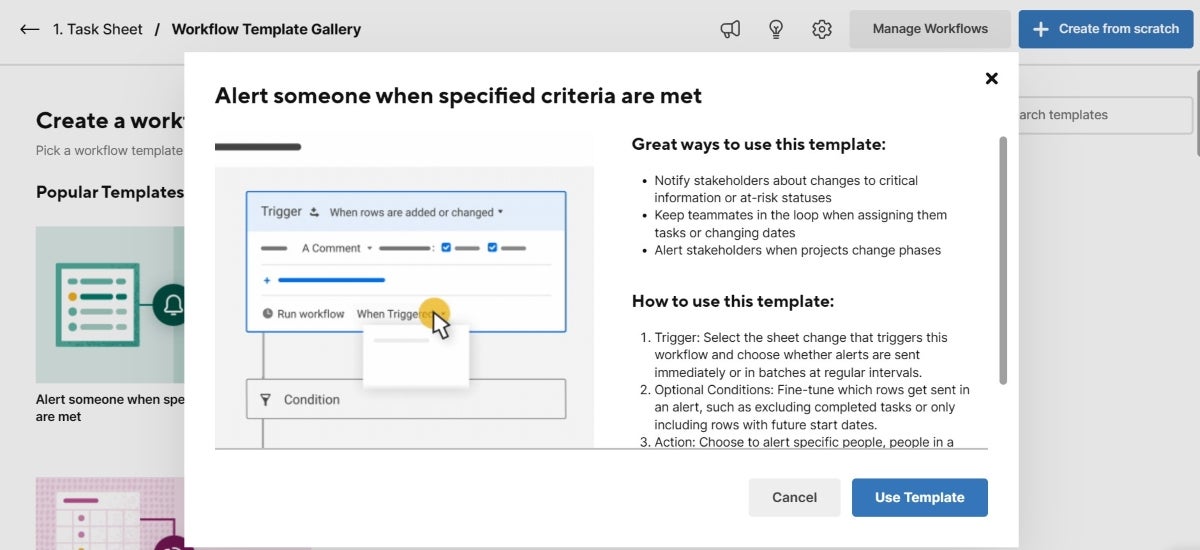
Pros and cons
| Pros | Cons |
|---|---|
| Familiar spreadsheet interface with advanced features. | Steeper learning curve compared to Airtable. |
| Strong integration with enterprise tools. | Mobile version lacks auto-save. |
| Robust automation and process management features. | Less intuitive for smaller teams. |
| Scalable for large teams and enterprises. | Limited features on the Pro plan. |
For more information, read the full Smartsheet review.
Wrike: Best for complex project management

Wrike is a leading project management software vendor that offers high-level project planning and management as well as seamless collaboration across teams. It’s designed for teams that manage complex projects and need advanced task management, collaboration, and reporting tools.
Wrike offers project management features targeted at IT project teams, marketing teams, creative teams, and service delivery teams. The platform can serve businesses of all sizes, with features and specialized offerings tailored to the needs of enterprise clients, and is a strong contender for teams that find Airtable too limiting for their more intricate project needs.
Why I chose Wrike
Wrike presents a level of project management sophistication that makes it a compelling alternative to Airtable, particularly for managing complex projects with multiple stakeholders. I found Wrike to excel in areas where Airtable might struggle, such as advanced reporting, resource management, and task dependencies. While Airtable is great for more simple setups, Wrike provides the tools necessary to handle projects with many moving parts.
Pricing
- Free: $0 to use basic task management functions.
- Team: $10.00 per user per month.
- Business: $24.80 per user per month.
- Enterprise: Custom pricing based on business needs.
- Pinnacle: Custom for large organizations.
Features
- Intuitive displays with table, list, board, Gantt, timelog, and analytics dashboard views.
- Project templates available for IT, project management, marketing, and other teams.
- 400+ integration options with a wide range of apps and tools.
- Premium security and data privacy features for enterprise users.
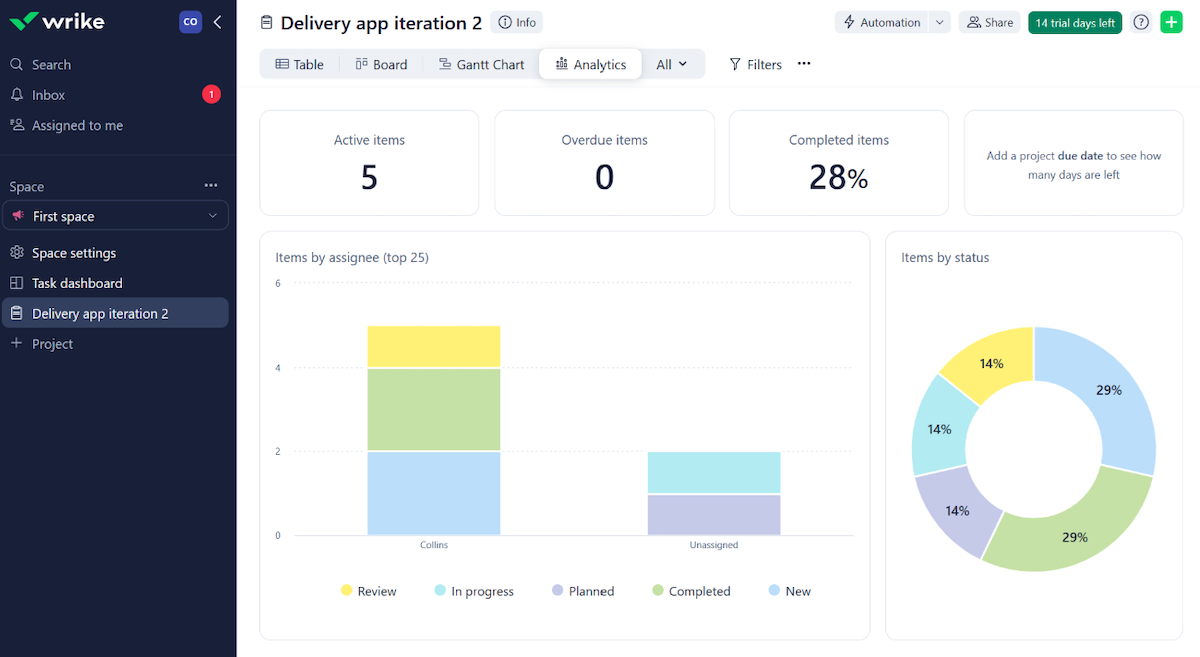
Pros and cons
| Pros | Cons |
|---|---|
| Excellent for managing complex projects. | Can be overwhelming for smaller teams. |
| Strong integration capabilities. | Higher pricing compared to some alternatives. |
| Real-time reporting and analytics. | Steeper learning curve. |
| Customizable workflows and dashboards. | Limited UI customization. |
For more information, read the full Wrike review.
Zoho Projects: Best for budget-conscious teams

Zoho Projects is a well-rounded project management tool for task management, process automation, and team collaboration. It is part of Zoho’s extensive software product catalog, making it an especially good choice for organizations that already use a Zoho product or are looking for multiple easy-to-integrate business tools.
The software offers a variety of data visualization options, including a traditional spreadsheet, simple list, kanban board, and Gantt chart views. Users can also automate mapped workflows with the Blueprint tool.
Why I chose Zoho Projects
With a starting price of $4 per user per month when billed annually, Zoho Projects is worth considering in place of Airtable when you need a more budget-friendly solution without sacrificing essential project management features. I found Zoho Projects to offer a great set of tools at a fraction of the cost of many competitors, making it accessible for smaller teams or startups. Its integration with other Zoho apps, like Zoho CRM and Zoho Books, allows for a seamless workflow across different business functions, which Airtable doesn’t offer natively.
Pricing
- Free: Supports up to three users and two projects with basic project management features.
- Premium: $4 per user per month, billed annually or $5 per user per month billed monthly.
- Enterprise: $9 per user per month, billed annually or $10 per user per month billed monthly.
Features
- Project tracking in spreadsheet, list, and kanban views.
- Integrations with other Zoho products, as well as with Google and Microsoft products.
- Project baseline feature to help compare expected vs. real progress on tasks.
- Ability to track and analyze time spent on each task.

Pros and cons
| Pros | Cons |
|---|---|
| Very affordable pricing. | Some advanced features require higher tiers. |
| Seamless integration with other Zoho apps. | Interface may feel outdated compared to competitors. |
| Effective set of features for small teams. | Limited scalability for very large teams. |
| Strong focus on time tracking and reporting. | Fewer customization options compared to Airtable. |
For more information, read the full Zoho Projects review.
Teamwork: Best for freelancers and contractors

Teamwork describes itself as a platform for managing clients’ work. The project management software helps teams manage tasks, projects, and workflows, making it easy for them to work collaboratively and stay organized. Teamwork allows professional services teams, creative teams, and agencies to create and assign tasks, set due dates and priorities, and track progress in real time.
Managers can also create sub-tasks, tags, and dependencies to break down projects into smaller tasks, assigning them to team members and tracking their progress. Time tracking and reporting tools are available to help users monitor how much time is spent on tasks and projects, as well as to generate reports that can be shared with clients or stakeholders.
Why I chose Teamwork
Teamwork delivers when it comes to client-facing work like managing client projects and tracking billable hours. Teamwork’s client-focused features, such as time tracking and invoicing stood out for me and separated it from Airtable. While Airtable is great for internal project management and data organization, Teamwork adds an extra layer of client management tools that make it easier to handle client communications, track project progress, and manage billing all in one place.
Pricing
- Free: No charge for up to five users.
- Deliver: $10.99 per user per month, billed annually, or $13.99 per user billed monthly.
- Grow: $19.99 per user per month, billed annually, or $25.99 per user billed monthly.
- Scale: $54.99 per user per month billed annually, or $69.99 per user billed monthly.
- Enterprise: Contact for quote.
Features
- Resource management capability.
- Client management tools, including invoicing and time tracking.
- Gantt charts, kanban boards, and workload management.
- Google Chrome extension and Gmail add-on enable users to use the tool from their browser and create tasks through the Gmail app.
- Integrations with over 350 tools, including Slack, Plecto, and Stripe.

Pros and cons
| Pros | Cons |
|---|---|
| Excellent for managing client projects. | Higher tiers needed for advanced features. |
| Strong time tracking and billing features. | Pricing can increase significantly for larger teams. |
| Easy client communication and project tracking. | The interface can feel cluttered with too many features. |
| Seamless integration with finance and CRM tools. | Teamwork removed the previously-available cheapest paid plan. |
For more information, read the full Teamwork review.
Jira: Best for agile teams

Jira is project management and issue-tracking software developed by Atlassian. It is used by software development teams to plan, track, and manage their projects and tasks. Jira offers a variety of features, such as agile project management, customizable workflows, issue tracking, project planning, and reporting. Agile teams can use Jira to manage their sprints, backlogs, and releases, while software development teams can use it to track and manage bugs, issues, and code changes.
Why I chose Jira
For any team that’s focused on software development or prefers to work with agile methodologies, I’d recommend Jira. While Airtable is excellent for general project management and database organization, Jira is purpose-built for agile methodologies like scrum and kanban. Jira’s deep integration with development tools and its extensive issue-tracking capabilities make it the go-to choice for software teams that need to manage tasks, bugs, and features in a highly structured environment.
Pricing
- Free: $0 for up to 10 users.
- Standard: $8.15 per user billed monthly and $850 annually for 1–10 user tier.
- Premium: $16 per user billed monthly and $1,600 annually for 1–10 user tier.
- Enterprise: Available for teams with 801+ users and only billed annually. Contact Jira sales for pricing.
Features
- Issue management and bug tracking.
- Role assignments.
- Integrations with over 3,000 third-party services.
- Agile project management capability with scrum and kanban boards.
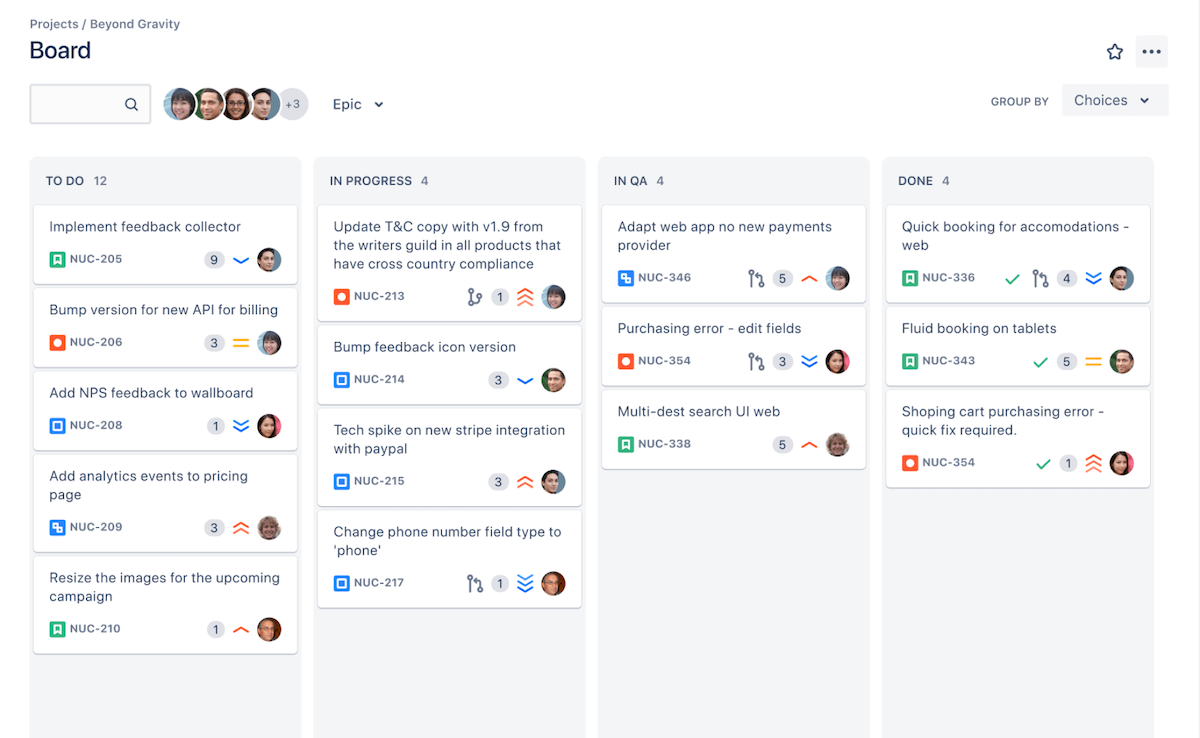
Pros and cons
| Pros | Cons |
|---|---|
| Ideal for agile software development. | Can be overwhelming for non-development teams. |
| Extensive issue and bug-tracking features. | Steeper learning curve for new users. |
| Strong integration with development tools. | Higher pricing for the Premium plan. |
| Customizable workflows for development processes. | UI could be more intuitive. |
For more information, read the full Jira review.
Confluence: Best for knowledge base management

Also developed by Atlassian, Confluence is a team collaboration and knowledge management software solution. It provides a platform for teams to create, share, and collaborate on content, such as documents, notes, meeting minutes, and project plans. It is designed to be a central hub for team communication and knowledge sharing.
Confluence is highly customizable, allowing teams to create their own spaces and pages, set up permissions and workflows, and integrate with other tools and services. It also supports real-time editing and commenting, version control, and search functions, making it easy to find and update information.
Why I chose Confluence
While Airtable is powerful for organizing data and tasks, Confluence impressed me with its ability to create a structured, easily navigable knowledge base where teams can document processes, track progress, and collaborate on content. Confluence’s integration with Jira makes it particularly valuable for development teams, allowing them to link project documentation directly with issues and tasks in Jira.
Pricing
- Free: No cost for up to 10 users.
- Standard: $6.05 per user if billed monthly, or $600 per year for 1–10 users.
- Premium: $11.55 per user if billed monthly, or $1,150 per year for 1–10 users.
- Enterprise: Contact for quote.
Features
- Centralized knowledge base for documentation and collaboration.
- Integration with Jira for seamless project management.
- Customizable templates for creating and organizing content.
- Real-time editing and collaboration with team members.
- Advanced search and organization tools to easily find information.
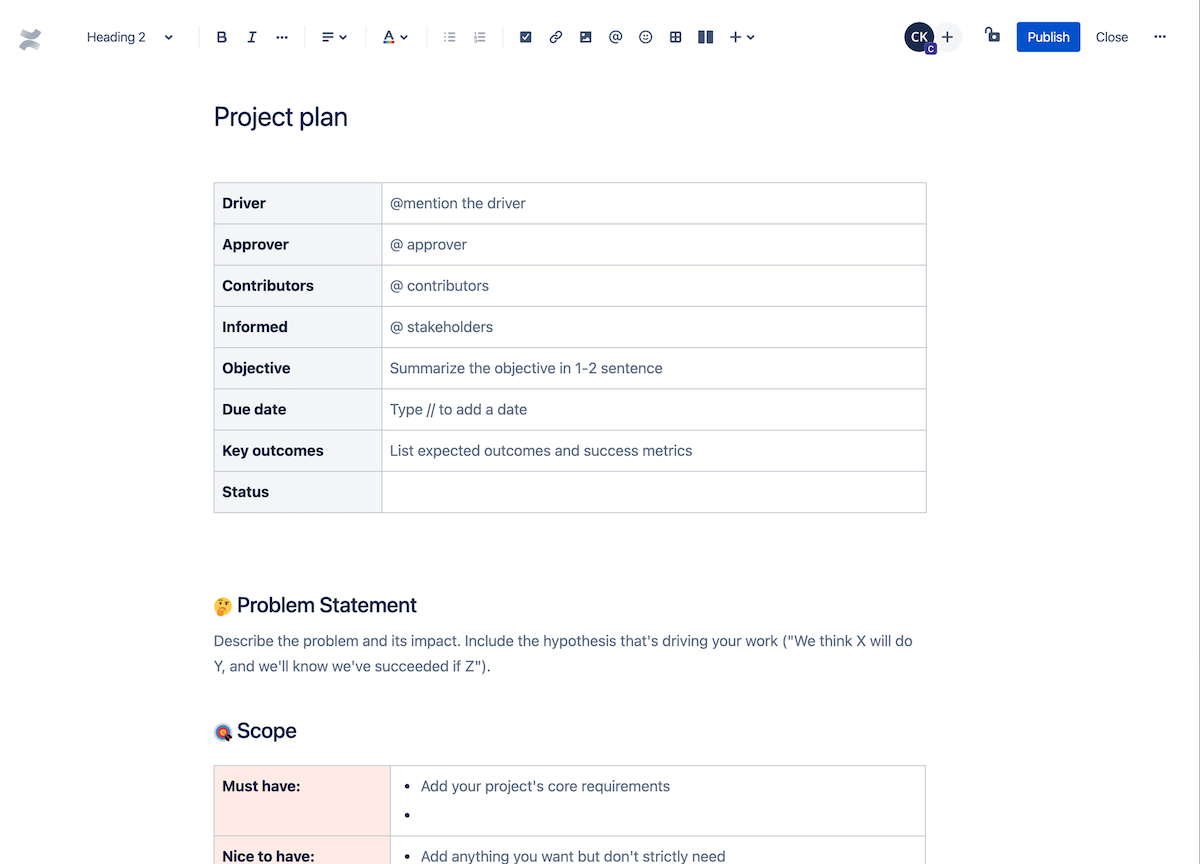
Pros and cons
| Pros | Cons |
|---|---|
| Excellent for creating and managing documentation. | Can be overkill for small teams with basic needs. |
| Strong integration with Jira and other Atlassian tools. | Learning curve for new users. |
| Real-time collaboration and editing. | Limited project management features compared to Airtable. |
| Customizable templates and knowledge organization. | Pricing increases with additional features and users. |
For more information, read the full Confluence review.
What are the pros and cons of Airtable?
Airtable is one of the most popular project management software tools. This is partially due to the versatility of the software. Airtable provides solutions for teams of all sizes, from small businesses to large enterprises, and there is even a free plan for smaller teams or individuals. Airtable also offers an intuitive user interface and a seamless data import process, making it a very user-friendly option.
However, there are a few reasons users may seek alternatives to Airtable. The first one is simply that many people have different preferences when it comes to the task management interface. Airtable’s interface is intuitive for most users, but it does feel more like a spreadsheet. Excel enthusiasts will like this, but others may prefer a layout that feels more like a standard to-do list.
Enterprise users may also choose to go with an Airtable alternative, as many competitors offer more comprehensive enterprise integrations. There are also limited extensions for many of the subscription plans.
Key features of Airtable alternatives
Task management
Similar to Airtable, the alternative tools in this list offer task management features for creating and assigning tasks, setting due dates and priorities, and tracking progress in real-time. These tools also allow for task dependencies, which means certain tasks cannot start until others are completed.
For instance, Teamwork has an essential tasks feature that enables users to create sub-tasks, tags, and dependencies, making it easy for managers to break down complex tasks into smaller tasks.
Communication capability
Collaboration features in project management tools help teams stay connected and communicate via team chats, comments, and notifications. Airtable alternatives like Notion and Zoho Projects also include features like real-time collaboration and file sharing to further improve team collaboration, communication, and productivity.
Workflow automation
Workflow automation tools streamline processes, reduce manual tasks, and improve efficiency. Airtable alternatives like monday.com and Wrike come with automated workflows and task notifications that allow users to quickly and easily automate processes and procedures. This may include automating repetitive tasks, such as sending emails or updating records, using triggers and actions.
Cost
Airtable alternatives come in a range of pricing plans, from free to high-ticket custom pricing. Prospective buyers should consider the user count, features, and support they need when selecting an alternative to Airtable that fits their budget. Alternatives like Teamwork, Zoho Projects, and Notion offer more affordable pricing plans for small teams, while others offer more robust features for larger teams.
Do you need an alternative to Airtable?
Airtable is a popular project management tool that essentially merges spreadsheets with databases. It allows users to organize information, manage tasks, and collaborate in a visually appealing interface. However, as versatile as Airtable is, it won’t be the perfect fit for every business or project.
You might seek an alternative to Airtable if you need more robust project management capabilities like time tracking or advanced reporting, which Airtable doesn’t natively provide. Additionally, if you handle large, complex projects, you may feel like Airtable’s features are too limited and likely prefer tools that offer more flexibility in managing tasks and resources. Alternatives like monday.com, ClickUp, and Smartsheet offer similar functionalities with additional features tailored to more complex project management needs.
How do I choose the best Airtable alternative for my business?
Airtable is a popular choice for project management software. It offers a wide range of strong project management and reporting features. However, it isn’t the best fit for all organizations, as it does have some weaknesses in its task management features.
To select the best Airtable alternative for your organization, consider your use cases, number of team members, the complexity of the project, type of project, budget, and required project management features. These factors will help you determine the best Airtable alternatives for your company.
I also recommend evaluating at least three Airtable alternatives before selecting one; sign up for a free plan or free trial if one is available, compare quotes, and analyze specific product features to ensure it meets your team and project needs.
There are plenty of alternative project management software options available. These competitors may offer better task management features or a preferable user experience compared to Airtable.
SEE: Learn more about the top tools with this roundup of the best project management software.
Review methodology
To form this list of Airtable alternatives, I first used Airtable to understand what it offers, then compared my experience with alternatives. Out of the pool of alternatives, I narrowed it down to the Airtable alternatives that offer unique value and use cases, based on five key data points: cost, task management capabilities, features, ease of use, and ability to meet specific team needs. I then compared my experience with the experiences of real-world users to see whether our experiences were aligned.
Frequently asked questions (FAQs)
What is Airtable?
Airtable is a cloud-based project management and database tool that delivers a mix of the features of a spreadsheet and the capabilities of a relational database. It allows users to organize and manage information in a flexible and visually appealing way, thus making it suitable for a wide range of use cases like project management, content calendars, inventory tracking, and more. Airtable’s interface is intuitive, making it accessible to users with varying levels of technical expertise.
Is Airtable free?
Yes, Airtable offers a free plan that provides basic features suitable for individuals or small teams. The free plan includes unlimited bases, 1,000 records per base, 1GB of attachment space per base, and the ability to have up to five editors. This plan is ideal for those just getting started or who have modest project management needs.
Is Airtable HIPAA compliant?
Airtable can be HIPAA compliant, but this is only available under its Enterprise Scale plan. For Airtable to be HIPAA compliant, users must sign a Business Associate Addendum (BAA) with Airtable. This ensures that Airtable meets the necessary safeguards to handle Protected Health Information (PHI) securely. Without these conditions, Airtable should not be used for storing or managing PHI.
How much does Airtable cost?
Airtable offers several pricing plans to cater to different user needs. The Free plan is available at no cost and is suitable for small teams or individuals, providing 1,000 records per base and 1 GB of attachment space. The Team plan costs $20 per seat per month when billed annually, or $24 per seat when billed monthly, offering 50,000 records per base and 20 GB of attachment space. The Business plan is priced at $45 per seat per month billed annually or $54 per seat billed monthly, and it supports 125,000 records per base and 100GB of attachment space. For larger organizations, the Enterprise Scale plan offers custom pricing and includes advanced features such as 500,000 records per base and 1,000 GB of attachment space.




